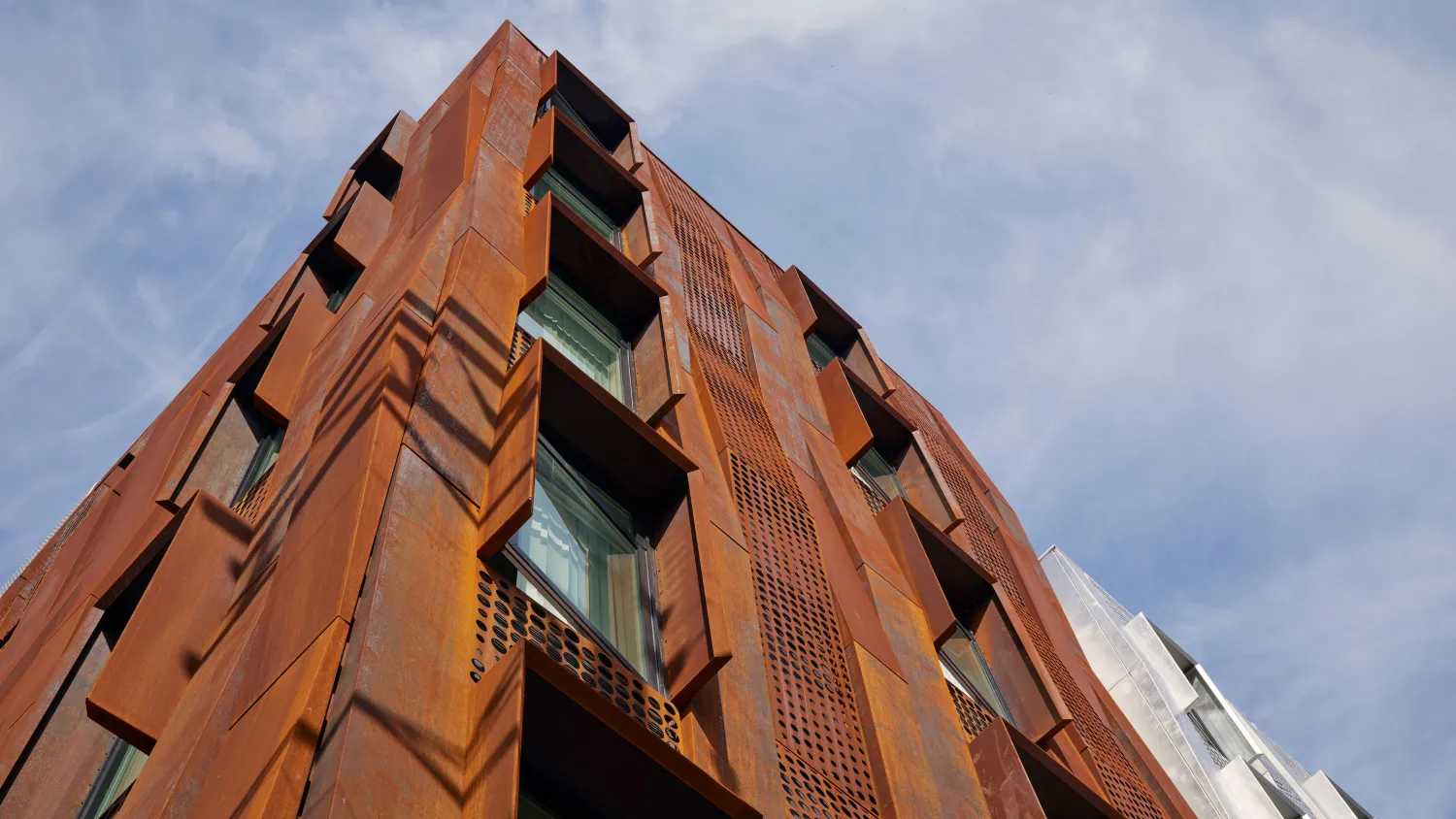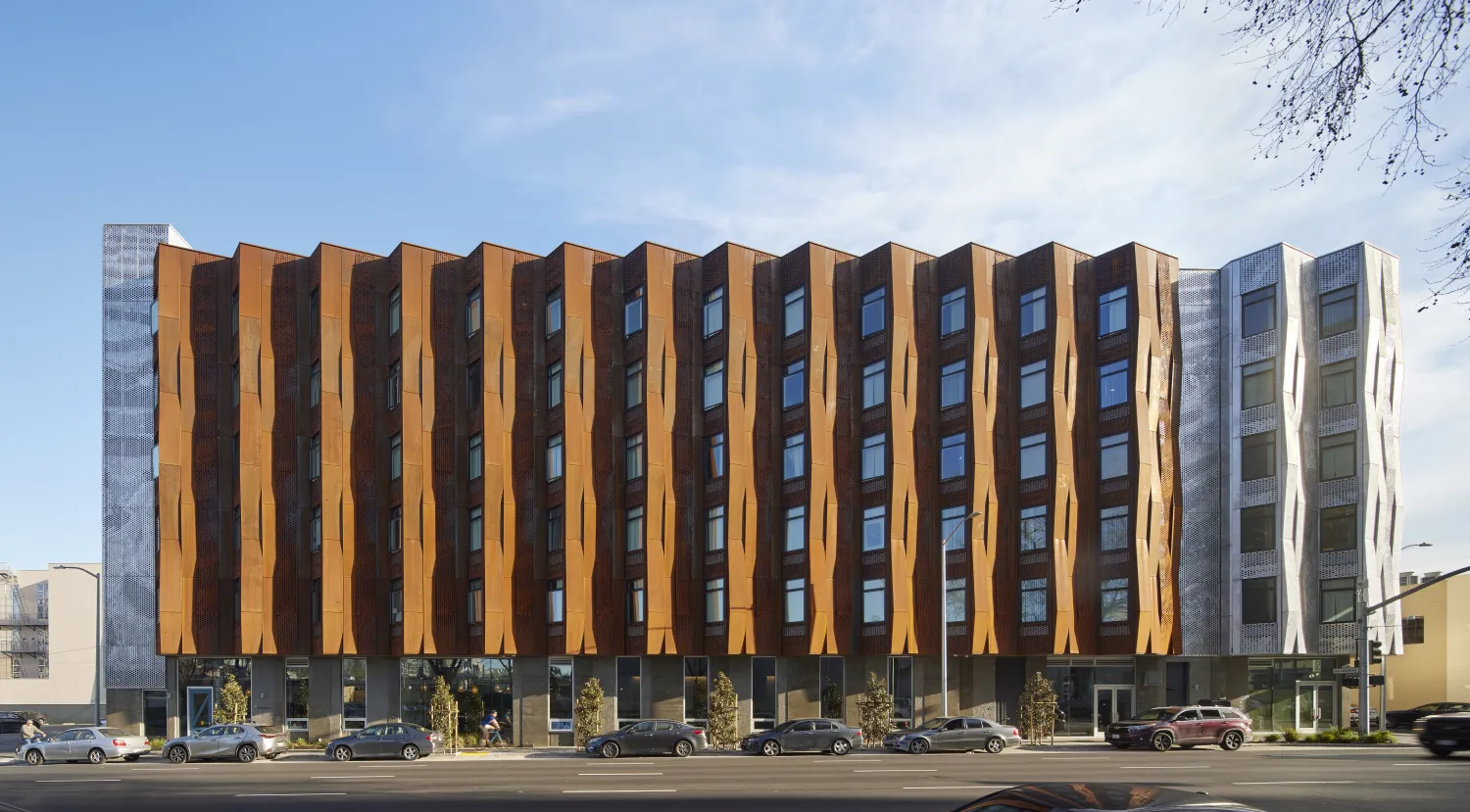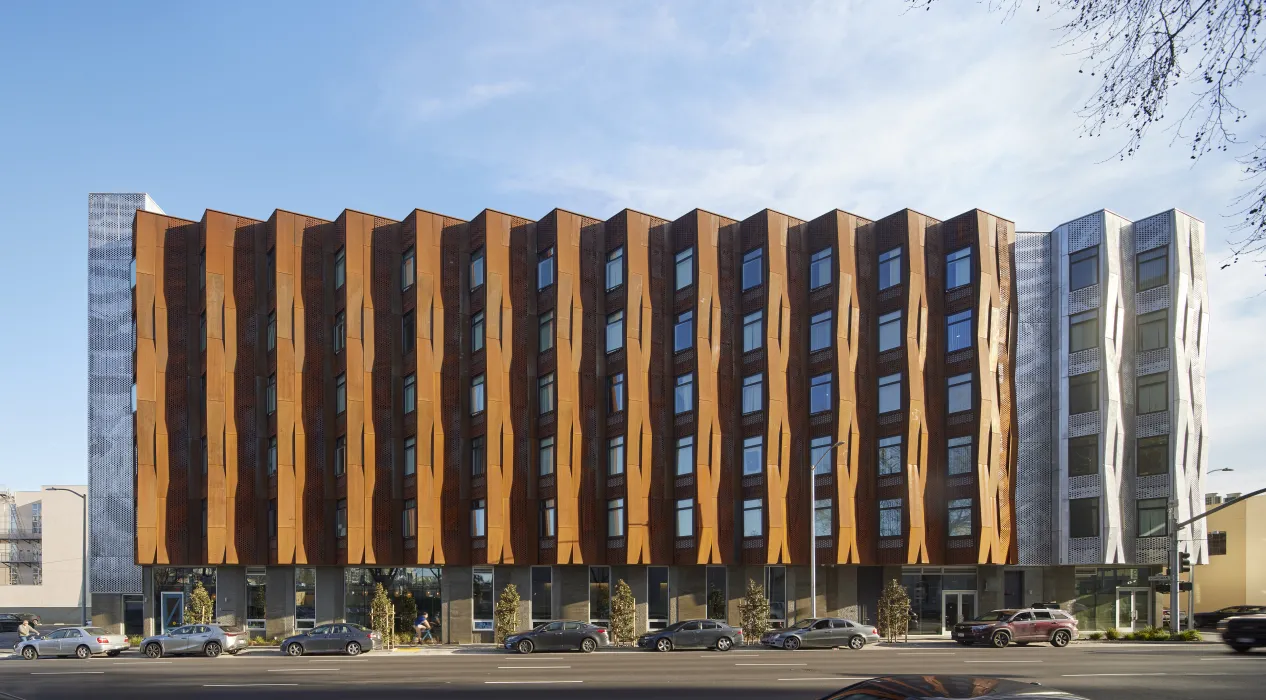
This week, we’ve gathered AN’s picks for the best facades covered in 2023. These projects were sourced from around the globe and exhibit a wide variety of material expressions, ranging from woven carbon and glass fiber to precast concrete and reclaimed brick. Check out our list to discover facades as diverse as an Armenian church in Texas, an archival vault in Canada, a low-income housing in The Bronx, and a community center in Chicago, to name a few.
Tahanan Supportive Housing Complex
David Baker Architects
San Francisco
In San Francisco, a city with the most severe housing shortage in the country, David Baker Architects designed an affordable housing project which provides 145 apartments to formerly homeless individuals. Composed of 87 wood framed modules, the complex is supported below by a concrete podium and clad in weathered steel and aluminum rainscreen panels. Window bays were offset from the plane of the facade in a sawtooth manner, optimizing a balance between natural light and shade.
Texoversum
Allmanwappner & Menges Scheffler Architekten
Reutlingen, Germany
Reutlingen University commissioned German firms Allmannwappner and Menges Scheffler Architekten to design a new headquarters for the School of Textiles & Design. The building is wrapped in a textile-inspired facade woven from carbon and glass fibers—the first facade system of its kind. Individual filaments were wound together robotically by a machine developed at the nearby University of Stuttgart. Through a computer aided design process, five woven tile templates were developed, which repeat across the facade.
MacKimmie Complex
DIALOG
Calgary, Canada
DIALOG’s adaptive reuse of the University of Calgary’s formerly Brutalist MacKimmie Complex is a near total transformation, which involved replacing the unwelcoming concrete facade of a midcentury library tower with a double skin glass envelope that self ventilates through automated windows. In addition to this, photovoltaic panels embedded in the curtain wall, advanced thermal regulation systems equipped with radiant panels, and diligent recycling of the facade’s original materials make this one of the highest performing projects in our coverage this year.
El Borinquen Residence
Alexander Gorlin Architects
Bronx, New York
Alexander Gorlin Architects latest supportive housing project, located in the Bronx, takes cues from the firm’s earlier multi-family work as well as the stylistic guidelines of Tropical Modernism. Framed by a concrete grid, colorful metal panels decorate the exterior of El Borinquen Residence and are reflected on the interior multi-colored tile around the elevator bank. The building is titled after the Taino name for Puerto Rico and provides 148 units of 100 percent affordable housing to the Morrisania neighborhood in the Bronx, a predominantly Latino enclave.
ETH Zurich GLC Research Building
Boltshauser Architekten
Zurich
Boltshauser Architekten’s design for ETH Zurich’s GLC Research Building recalls the architectural legacy of modernism through its facade, which alternates between bands of glass blocks and glazed curtain wall. This simple organization conceals a double skin design, which allows for movement and conditioning of air in the gap between the two systems. Furthermore, the exterior glazing functions as a Brise-soleil, filtering light and solar radiation before it enters the interior space.
St. Sarkis Armenian Orthodox Church
David Hotson Architect
Carrolton, Texas
Named the best new building in Texas by Dallas Morning News architecture critic Mark Lamster, the St. Sarkis Armenian Orthodox Church was designed by New York–based practitioner David Hotson to mimic the form of the St. Hripsime Church, a more than 1,000 year old church in Yerevan, Armenia’s capital. The Western elevation of the church is clad in porcelain rainscreen panels printed with 1.5 million Armenian decorative motifs representing, in number, the victims of the Armenian genocide. When viewed together, these motifs form a raster image of a cross.
Dior, Lusail
Aranda\Lasch
Lusail, Qatar
Dior’s first storefront in Qatar, located within the aspirationally Parisian Place Vendome shopping mall, was designed with a facade inspired by the pleats in a Dior dress. Designers at Aranda\Lasch created rippled fin patterns which were manufactured from the synthetic stone HIMACS. An additional layer, composed of triple laminated glass, filters the backlighting to create texture and pattern across its folding retail frontage.
Ascentage Pharmaceuticals Headquarters
OLI
China
Glass sheathed by a hexagonal aluminum lattice provides the perfect visual metaphor for the headquarters of Ascentage Pharmaceuticals. Inspired by the benzene ring, New York–based firm OLI’s top-heavy volumes rest over reflective pools in a nod to the scholar’s gardens of Suzhou, where the headquarters is located. The pharma-inspired shade screen and a low-e coated glass, improves the energy performance of the buildings, while maintaining a healthy supply of natural light to the interior. Around corners, the glass, as well as its exterior skin, curve. To maintain the hexagonal patterning around these curves, OLI used a parametric model.
Library of Canada Archival Vault
B+H Architects
Gatineau, Quebec
Commissioned by Library and Archives Canada, B+H created a massive archival vault in Gatineau, Quebec, to complement the organization’s preexisting Preservation Centre. Boasting that it is the first net-zero archival facility in the Americas, B+H designed the facility according to passive house guidelines, allowing for precise regulation of temperature and humidity which is important to the preservation of archival collections. The facade is clad in precast concrete panels and adorned with the textures of the geological strata found beneath Quebec. Within the vaults a robotic storage and retrieval system is used to transfer materials between the vaults and the building’s administrative floor.
The Grand Mulberry
Morris Adjmi Architects
Manhattan
A new residential building on Grand and Mulberry street by Morris Adjmi Architects refers to the Italianate design of the Lower East Side’s tenement buildings. Hand-molded masonry manufactured by Glen Gery decorates the facade, featuring half sphere ornaments which cast intricate shadows throughout the day. The ornamental detailing of the masonry mimics the grid of punched windows covering the facade. Offset from the actual glazing, the pattern creates a sense of two-dimensional relief and depth.
Chicago Park District Headquarters
John Ronan Architects
Chicago
In Chicago’s Brighton Park neighborhood, John Ronan Architects have inaugurated a new public park, and headquarters for the city’s park district on a former industrial site. Utilizing reclaimed Chicago brick from the demolition of two nearby buildings, the headquarter’s light colored masonry is complemented by bronze tinted glazing, and anodized aluminum screens. The salvaged bricks were tested for absorption and compression, and later sorted according quality.
Rob and Melani Walton Center for Planetary Health
Grimshaw, Architekton
Tempe, Arizona
Grimshaw and Architekton’s design for the Rob and Melani Walton Center for Planetary Health building at Arizona State University consists of a glass fiber reinforced concrete (GFRC) exterior wrapping, paired with a semi transparent greenish-blue glass and metal panel enclosure surrounding the building’s generous interior courtyard. Inspired by the natural forms found in the desert, the firm’s design can be interpreted to refer to the structure of a cactus or geode given the contrast between its scale-like exterior, and lighter, more colorful interior.
View the full article: These are the top facades AN covered in 2023 which appeared in The Architect’s Newspaper on December 15, 2023.

